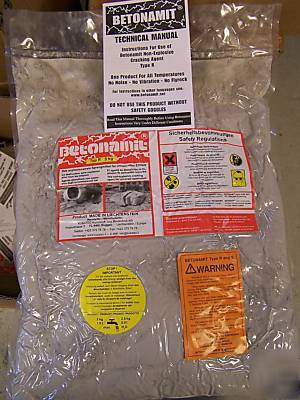Chicago Industrial Reuse and Parts Blog-Newsgroup > Cook County
> New
> Commercial
> Office Related
> Betonamit non-explosive cracking agent type r
Betonamit non-explosive cracking agent type r
One Product for all Temperatures
No Noise - No Vibration - No Flyrock
Betonamit non-explosive cracking agent is a non-toxic powder. When mixed with water and poured into holes
1 1/4", 1 3/8" or 1 1/2" diameter, it hardens and expands, exerting pressures of 12,000 psi. Reinforced concrete,
boulders, and ledge are fractured overnight with no noise, vibration, or flyrock
NEW! Watch time lapse videos of Betonamit breaking concrete!
Betonamit is perfect for indoor and
outdoor demoltion projects including:
No licenses or permits required
One product for all temperatures
Always wear safety goggles when using Betonamit!
Read instruction manual before use!
Betonamit is pronounced Beh-tah-nuh-mite
Betonamit has been used safely and with great results by thousands of contractors and
homeowners all over the world. Safe use depends on following instructions and wearing
safety goggles at all times. Although non-toxic, Betonamit is caustic, and can cause severe eye injury if splashed into eyes while mixing or pouring.
Also, the chemical reaction of Betonamit and water generates heat. If this reaction goes too quickly, the temperature can go above the boiling point of water before all the water has chemically com bined with the Betonamit. This can result in a steam-driven explosion which blows the Betonamit from the hole with sudden force.
To avoid blowouts, follow the instructions regarding mix water temperatures and hole sizes, as told later in the manual. Always wear safety goggles , and never use drill holes larger than 1-1/2" diam eter. Blow dust out of the holes after drilling, and keep Betonamit cool before use.
1. Maximum Hole Depth is 10 feet.
2. Minimum Hole Depth is 4 times hole diameter; for example 5" with 1-1/4" hole, 6" with 1-1/2".
Holes shallower than 4 times diameter are likely to blow out.
3. In reinforced concrete, drill 85 to 90% of its depth. In ledge, drill as deep as you want to remove. In boulders, drill 2/3 to 3/4 of the rock's thickness.
1. Holes must be drilled so as to allow a free face for the Betonamit to push toward. For example, drilling at 45o angle in a flat surface of ledge will push it upwards, but drilling straight down might not allow anywhere for the pressure to go.
2. To demolish a slab without pushing out the walls which surround it, drill a cone shaped pattern at the center and fill these holes first. The cone will pop upwards and create a free face.
3. Hole pattern depends on tensile strength of what you're breaking, amount of rebar if any, and the size of the pieces you want when you're done. This can often be determined by experiment; a good starting point is to space holes one foot on center in rows one and a half feet on center. In non-reinforced concrete, holes may be spaced as far apart as 24".
4. Hole pattern also depends on how fast you need results. More holes spaced closer together will live faster break times and smaller pieces, but this costs more in labor and Betonamit.
6. When removing part of a slab, you will want to prevent cracks from spreading into the rest of the slab. Drill holes 6" on center in a line between the "demolish" section and the "keep" section, then fill every third hole. The empty holes form weak points and prevent cracks from spreading into the "keep" section.
7. Empty holes can also be used to direct cracks -they cost less than filled holes. For example, if you want to break a boulder into thirds, you can use this pattern:
This will save money campared to filling all the holes, but will slow down the breaking time.
These instructions are essential for safe and effective use of Betonamit.
1-1/4", 1-3/8", or 1-1/2" dia.
When rock or concrete is above 73 F, add 5 ounces of extra water per 5 kilo container, 33(iced).
Halve this amount when using Type S in 2-1/2 kilo containers.
Over 95 F cool holes with cold water, then blow out before installing Betonamit.
1. Hole temperature can often be reduced by waiting until late night or early morning.
2. When rock or concrete is above 65oF, keep the Betonamit as cool as possible before use.
3. When rock or concrete is above 85oF, store Betonamit in a cooler with ice or in a refrigerator before use.
4. When rock or concrete is above 73oF, do not mix more than one 5 kilo container at a time.
5. Measure the rock or concrete temperature - DON'T GUESS! Tie a string onto the thermometer and lower it into the drill hole.
Call Toll Free (***)-573-0445 Or email: ****@albanycountyfasteners.com

